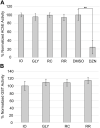Comparative toxicity assessment of glyphosate and two commercial formulations in the planarian Dugesia japonica
- PMID: 37435546
- PMCID: PMC10332155
- DOI: 10.3389/ftox.2023.1200881
Comparative toxicity assessment of glyphosate and two commercial formulations in the planarian Dugesia japonica
Abstract
Introduction: Glyphosate is a widely used, non-selective herbicide. Glyphosate and glyphosate-based herbicides (GBHs) are considered safe for non-target organisms and environmentally benign at currently allowed environmental exposure levels. However, their increased use in recent years has triggered questions about possible adverse outcomes due to low dose chronic exposure in animals and humans. While the toxicity of GBHs has primarily been attributed to glyphosate, other largely unstudied components of GBHs may be inherently toxic or could act synergistically with glyphosate. Thus, comparative studies of glyphosate and GBHs are needed to parse out their respective toxicity. Methods: We performed such a comparative screen using pure glyphosate and two popular GBHs at the same glyphosate acid equivalent concentrations in the freshwater planarian Dugesia japonica. This planarian has been shown to be a useful model for both ecotoxicology and neurotoxicity/developmental neurotoxicity studies. Effects on morphology and various behavioral readouts were obtained using an automated screening platform, with assessments on day 7 and day 12 of exposure. Adult and regenerating planarians were screened to allow for detection of developmentally selective effects. Results: Both GBHs were more toxic than pure glyphosate. While pure glyphosate induced lethality at 1 mM and no other effects, both GBHs induced lethality at 316 μM and sublethal behavioral effects starting at 31.6 μM in adult planarians. These data suggest that glyphosate alone is not responsible for the observed toxicity of the GBHs. Because these two GBHs also include other active ingredients, namely diquat dibromide and pelargonic acid, respectively, we tested whether these compounds were responsible for the observed effects. Screening of the equivalent concentrations of pure diquat dibromide and pure pelargonic acid revealed that the toxicity of either GBH could not be explained by the active ingredients alone. Discussion: Because all compounds induced toxicity at concentrations above allowed exposure levels, our data indicates that glyphosate/GBH exposure is not an ecotoxicological concern for D. japonica planarians. Developmentally selective effects were not observed for all compounds. Together, these data demonstrate the usefulness of high throughput screening in D. japonica planarians for assessing various types of toxicity, especially for comparative studies of several chemicals across different developmental stages.
Keywords: GBH; behavioral screening; ecotoxicology; flatworm; glyphosate; herbicide; neurotoxicity; new approach method.
Copyright © 2023 Fuselier, Ireland, Fu, Rabeler and Collins.
Conflict of interest statement
E-MC is the founder of Inveritek, LLC, which offers planarian HTS commercially. The remaining authors declare that the research was conducted in the absence of any commercial or financial relationships that could be construed as a potential conflict of interest.
Figures




Similar articles
-
Oxidative Stress and Cytotoxicity Induced by Co-Formulants of Glyphosate-Based Herbicides in Human Mononuclear White Blood Cells.Toxics. 2023 Dec 1;11(12):976. doi: 10.3390/toxics11120976. Toxics. 2023. PMID: 38133378 Free PMC article.
-
Concerns over use of glyphosate-based herbicides and risks associated with exposures: a consensus statement.Environ Health. 2016 Feb 17;15:19. doi: 10.1186/s12940-016-0117-0. Environ Health. 2016. PMID: 26883814 Free PMC article.
-
In vivo estrogenicity of glyphosate, its formulations, and AMPA on transgenic zebrafish (Danio rerio) embryos.Environ Pollut. 2024 Feb 1;342:123113. doi: 10.1016/j.envpol.2023.123113. Epub 2023 Dec 8. Environ Pollut. 2024. PMID: 38072021
-
Is it time to reassess current safety standards for glyphosate-based herbicides?J Epidemiol Community Health. 2017 Jun;71(6):613-618. doi: 10.1136/jech-2016-208463. Epub 2017 Mar 20. J Epidemiol Community Health. 2017. PMID: 28320775 Free PMC article. Review.
-
Glyphosate Herbicide: Reproductive Outcomes and Multigenerational Effects.Front Endocrinol (Lausanne). 2021 Jul 7;12:672532. doi: 10.3389/fendo.2021.672532. eCollection 2021. Front Endocrinol (Lausanne). 2021. PMID: 34305812 Free PMC article. Review.
Cited by
-
Statistical analysis of multi-endpoint phenotypic screening increases sensitivity of planarian neurotoxicity testing.Toxicol Sci. 2025 Aug 21:kfaf117. doi: 10.1093/toxsci/kfaf117. Online ahead of print. Toxicol Sci. 2025. PMID: 40839344 Free PMC article.
-
Oxidative Stress and Cytotoxicity Induced by Co-Formulants of Glyphosate-Based Herbicides in Human Mononuclear White Blood Cells.Toxics. 2023 Dec 1;11(12):976. doi: 10.3390/toxics11120976. Toxics. 2023. PMID: 38133378 Free PMC article.
-
Distinguishing classes of neuroactive drugs based on computational physicochemical properties and experimental phenotypic profiling in planarians.PLoS One. 2025 Jan 30;20(1):e0315394. doi: 10.1371/journal.pone.0315394. eCollection 2025. PLoS One. 2025. PMID: 39883642 Free PMC article.
-
How neurobehavior and brain development in alternative whole-organism models can contribute to prediction of developmental neurotoxicity.Neurotoxicology. 2024 May;102:48-57. doi: 10.1016/j.neuro.2024.03.005. Epub 2024 Mar 28. Neurotoxicology. 2024. PMID: 38552718 Free PMC article. Review.
References
-
- Avigliano E., Schenone N. F. (2015). Human health risk assessment and environmental distribution of trace elements, glyphosate, fecal coliform and total coliform in Atlantic Rainforest mountain rivers (South America). Microchem. J. 122, 149–158. 10.1016/j.microc.2015.05.004 - DOI
-
- Benbrook C. M. (2019). How did the US EPA and IARC reach diametrically opposed conclusions on the genotoxicity of glyphosate-based herbicides? Environ. Sci. Eur. 31, 2. 10.1186/s12302-018-0184-7 - DOI
-
- Benjamini Y., Hochberg Y. (1995). Controlling the false discovery rate: A practical and powerful approach to multiple testing. J. R. Stat. Soc. Ser. B Methodol. 57, 289–300. 10.1111/j.2517-6161.1995.tb02031.x - DOI
Grants and funding
LinkOut - more resources
Full Text Sources

